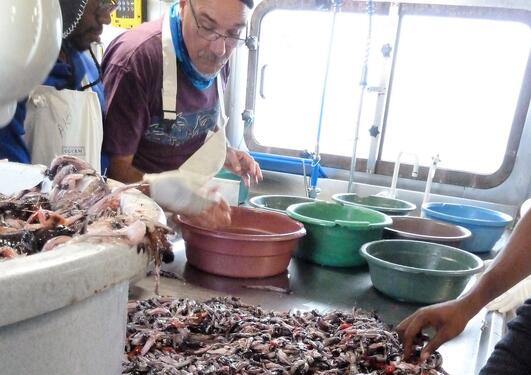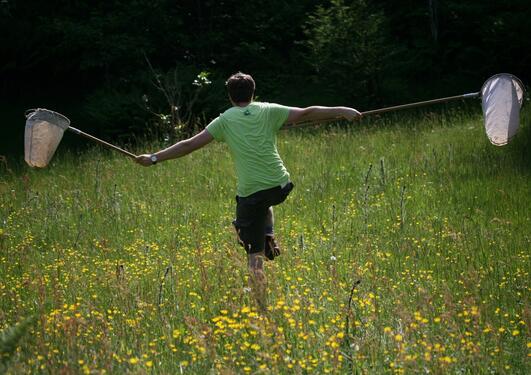Projects
Our current projects and research themes
Main content
CliFord (2022 - 2025)
Climate change and sustainability in Norwegian Fjords.
WP3 Biophysical interactions; WP3 PI: N. Gallo
The anthropogenic pressure on Norwegian fjords is increasing, and there are repeated reports on deteriorating conditions in the deep fjord basins. Meanwhile, climate trends in the offshore waters affect the renewal of these deep-basin waters. To sustainably manage our fjords, we need to understand how present and past changes in the physical and geo-chemical environment impact the fjord ecosystem. The main objective of CLIFORD is to study how climate change will alter the carrying capacity of Norwegian fjords and improve modelling tools.
This work program will examine the ecological impacts of physical drivers of change in the fjord ecosystems. The ecological impacts of recent climate-related deoxygenation events in western Norwegian fjords remain unknown. We will address this knowledge gap using existing time series, new observations, and numerical models. The RCN-funded HypOnFjordFish project has a unique ecological time series from Masfjorden of mesopelagic and demersal communities during the time period when the fjord transitioned from a well to poorly oxygenated system (2011-2021). Analysis of this time series will be paired with additional field campaigns to Masfjorden and contrasting fjords, to examine how climate-relevant variables (e.g. O2, pH, temperature, freshwater input) affect the community composition, abundance, and diversity of pelagic and demersal species in the fjords. Since benthic trawling is no longer permitted in most fjords due to internet cables, an autonomous seafloor lander will be used to collect data on the benthic community.
The deep-sea lander, DOV BEEBE, can collect paired physical, biological, and biogeochemical timeseries at pre-programmed intervals and will be deployed for ~1-month periods to sill and fjord bottom depths to examine seafloor community composition, diversity, and abundance, under hypoxic/low pH versus well-oxygenated/high pH conditions. DOV BEEBE has previously been used to characterize seafloor community responses to deep water oxygen variability in the Southern California Bight (Gallo et al. 2020) and will be transported to UiB from the Scripps Institution of Oceanography.
Gallo ND, Hardy K, Wegner NC, Nicoll A, Yang H, Levin LA (2020) Characterizing deepwater oxygen variability and seafloor community responses using a novel autonomous lander. Biogeosciences 17:3943-3960

HypOnFjordFish (2020-2023)
Hypoxia effects On Fjord Fish: harnessing the power of multidisciplinary studies.
NFR: NOK 12 mill; PI: A. G. V. Salvanes
This project uses West Norwegian fjords as natural infrastructures to generate new knowledge on the effects of hypoxia on mesopelagic and demersal fish communities. Such information is needed for sustainable management of marine resources, and for determining optimal coastal and fjord sites for fish farming, representing one of Norway's largest, most successful industries. Deoxygenation linked to ocean warming is a large concern worldwide. Loss of oxygen is pronounced in the open ocean, occurring in coastal waters, enclosed seas, and fjords. Little is known on how hypoxia affects marine ecosystems. Studies are difficult in open oceanic ecosystems but are more readily conducted in enclosed systems. West Norwegian fjords are unique in this respect. Their gradients of hypoxia are tractable for study and provide natural parallels with open ocean gradients. Each fjord contains an ecosystem with many physical and biological processes similar and relevant to those of large oceanic ecosystems. Masfjorden has repeatedly been sampled over the years, and it is documented that this fjord turned hypoxic in 2016. We have unique data from before and after 2016, enabling the study of deoxygenation effects on a well-documented ecosystem. It also serves as a comparison with other fjords on the effects of oxygen loss on vertical migration behaviors, fish physiology, trophic interactions, behavioral responses to changes, growth, and consequences for populations and communities. In addition, we will use advanced technology to examine if trace-element deposition in earstones from a long-lived deep-water fish provides information about previous periods of low oxygen levels in the fjords. We will also attempt to establish lab populations for two mesopelagic species for studies of physiology and growth. Outreach from the project is regularly published on the project web page where also our work packages are presented.

CRIMAC (2020 - 2027)
Centre for Research based Innovation in Marine Acoustic abundance estimation and backscatter Classification.
PI: Nils Olav Handegard, Institute of Marine Research - (UiB-BIO partner: AGV Salvanes)

PRIMA Learning (2018 - 2023)
Connecting hands-on-PRactice and Innovative MArine ecological sampling methods and analysis tools for enhancing student Learning of ocean science.
Mobility project. RCN funding NOK 4.5 mill; PI: A. G. V. Salvanes
The PRIMA LEARNING seeks to support mobility and strengthening of research networks on ocean sciences between Norway and South Africa in 2019-2023. It is a cooperation between research and education institutions in the two countries.
In PRIMA LEARNING research and education meet. Our approach is capacity building through research, combined with international experience and the establishment of networks for young researchers. We organise and fund workshops, intensive university courses, and participation on research cruises. Our courses and workshops include active teaching and learning methods, with an emphasis on hands-on learning or practical skills of sampling techniques
PRIMA LEARNING is built around the philosophy of BIO's Centre for Excellence in Teaching, bioCEED, and integrates active learning of theory, practical skills training, and societal relevance.
What does PRIMA Learning fund? Check out our web page: https://www.uib.no/en/bio/123072/prima-learning
GENSINC (2016 - 2021 - UiB Ph.D. project 2021 - 2024)
GENetic adaptations underlying population Structure IN herring, Clupea harengus.
PI: A. Folkvord
Atlantic herring is an important species in the pelagic fisheries with average annual harvest rates exceeding a million tons in the North-eastern Atlantic. Herring display a remarkable variability in phenotypes, e.g., size-at-age and timing of spawning, but at the same time a low genetic divergence between herring populations. The observed genetic difference between populations has however been suggested to be of adaptive relevance. Recent advances in genomics can now be used to document variability in genes with potentially high adaptive significance.
During the project period, we have for the first time produced viable second-generation offspring of herring from parents that have been raised their entire life under controlled experimental conditions. The studies have shown that the parental adaptation to salinity conditions during maturation subsequently influenced offspring fertilization success at different salinity conditions. Ongoing genetic analyses will reveal if specific genes are over-represented (selected) in the surviving offspring.
Studies of mutations rates in herring from our experimental populations have shown that it is among the lowest documented so far in vertebrates. This may be a contributing factor to the relatively low genetic variability typically observed between different herring populations. An example of a mutation with adaptive significance is found in the genes coding for rhodopsin, where the Baltic herring has a variant commonly found in freshwater fishes, while the Atlantic herring has a variant commonly found in marine fishes.
The efforts on collecting samples and undertaking genetic analyses from different natural herring populations have shown clear regional differences, and genetic assays have been developed that easily will clarify the genetic origin of sampled material. As an example, genetic markers to distinguish spring- and autumn-spawning herring have been developed, and international sampling programs are ongoing to document the utility of these genetic markers for herring stock management in collaboration with the International Council for the Exploration of the Seas (ICES).
A new experiment has been initiated where herring from different populations have been crossed and raised at different temperature and seasonal light regimes. The work is two years on the way and has generated data on phenotypic variability generated by seasonal light and temperature differences. Genetic markers have been developed to identify individuals to specific parental genotypes. The rearing and genotyping of sampled material will continue until expected maturation at age three years (in 2022). The data will be part of an additional project co-funded Ph.D. (2020-2024).


